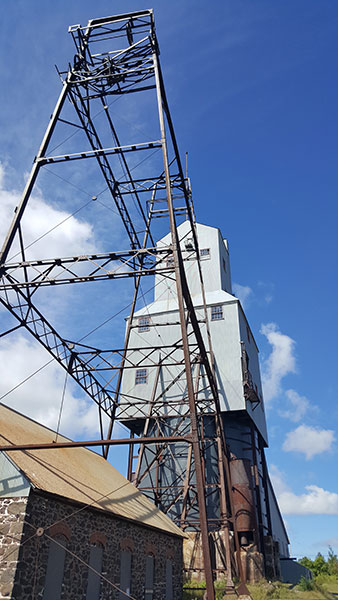Six Michigan Ghost Towns to Explore
When you think of ghosts towns, you probably don’t think of Michigan. But even though we may not have tumbleweeds rolling down the streets past old saloons, the Mitten State has plenty of mysterious ghost towns to explore. Here are just six of them.
Upper Peninsula Ghost Towns
Fayette
You’ll find Fayette on U.S. 2, along Lake Michigan’s northern shoreline, between Escanaba and Manistique. Once a booming industrial town, the remains of historic Fayette are now a state park.
In the mid-1800s, Fayette smelted iron ore from Michigan mines into pig iron for sale to steel manufactures. If was the perfect location, close to the natural resources needed to produce pig iron and near a suitable shipping harbor. The smelting operations included two blast furnaces, a large dock and several charcoal kilns. For the 24 years the furnaces operated, 500 workers and their families called Fayette home. When the market for their product declined, the Fayette operation was closed in 1891.
Today, the hulking ruins of the furnace complex still stand along with 18 other structures, including public buildings and homes. A visitor’s center, museum and walking tour tell visitors the story of this abandoned town.
Quincy Mine
Most ghost towns in the Upper Peninsula are casualties of the once thriving mining industry. Quincy Mine is on U.S. 41, just outside of Houghton. The copper mine operated in some capacity from 1846 through the 1970s. To draw workers to the mine, the company built and provided housing for them. The dwellings started out as simple tents. Eventually three-story houses with electricity and running water were built, drawing the industry’s best to work at Quincy.
Today the mine and surrounding land are designated as a National Landmark Historic District. A tour takes visitors down to the mine’s 7th level and through the hoist house. Visitors can also tour a company house, museum and several other buildings on the grounds.

The Quincy Mine #2 Shaft-Rockhouse.
Central Mine
The remains of Central Mine are located on U.S. 41 on the Keweenaw Peninsula, near Mohawk. The Village of Central Mine grew up around the prosperous copper mine it’s named after. The mine had a rich load and operated for almost 50 years, beginning in 1854. The village once had 130 structures and 130 residents. The mine ceased operations in 1898, and residents slowly began to move away. The last permanent resident left in 1952. A few of the buildings are still used as summer homes.
Today, the mine, village and surrounding area are designated as a state historic site. Twenty structures still stand, including the Central Mine Methodist Church and several houses. A visitor’s center tells the story of the mine and village, and a few structures are open to the public.
Lower Peninsula Ghost Towns
Singapore
The logging town of Singapore was a second-hand casualty of the Great Chicago Fire in 1871.
You can’t see much of what’s left of it anymore, though it’s ruins are located where the Kalamazoo river flows into Lake Michigan, near the resort towns of Saugatuck and Douglas.
Founded in 1836, Singapore was once home to three mills, two hotels, several general stores, a prosperous bank, and Michigan’s first schoolhouse. After the Chicago fire, demand for lumber was high. The land around Singapore was deforested as its mills struggled to keep up with needs on the other side of the lake. Without the protective cover of the trees, strong winds blowing across Lake Michigan eroded the sandy soil and buried the town under massive dunes.
The dunes continue to shift and grow today. Once in awhile, a roofline from one of the old buildings is uncovered. A historic marker in downtown Saugatuck remembers the town and serves as a warning about what happens when the delicate balance of nature is disrupted. In recent years, efforts have been made to slow and prevent further erosion in the area. The Saugatuck Dune Ride Company takes visitors near the buried ruins while sharing the story of the town’s sad demise.
Fallasburg
Though long abandoned, the Fallasburg pioneer village remains a popular tourist destination, because it’s home to one of only three covered bridges in Michigan still open to vehicle traffic. A sawmill and furniture factory created a boom along the river where Fallasburg was established in 1841. Eventually the town began to fade when the railroad drew people a few miles away to Lowell in 1858.
Drive over the covered bridge that crosses the Flat river, and you’ll find yourself transported to another time. The local historical society has preserved a one-room schoolhouse, two homes, including that of founder Wesley Fallas, a farm and the cemetery.The bridge is always open to visitors. Most Sundays, June through September, you can tour the schoolhouse.

The Fallasburg covered bridge.
Antrim City
Your have to look really hard to find any remains of Antrim City, along Old Dixie Highway, between Eastport and Charlevoix. Established as a port on Lake Michigan, the city quickly disappeared when the harbor was found to be too shallow for anything but small boats. The dock was moved to nearby Norwood, and Antrim City faded into history.
Today the land is part of The Antrim Creek Natural Area, open for public use. It includes beach access, cedar swamps, low dunes and the creek. A one-room schoolhouse and a few headstones can still be found. If you look closely, you may see some other old foundations and trees growing in straight lines that seem to indicate where streets once were.



